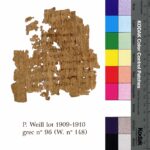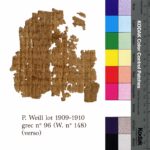| Artefact ID | 517 |
| TM ID | TM 59996 |
| Findspot (DEChriM ID) | - () | Class | Textual |
| Material | Papyrus |
| Writing medium | Codex |
| Text content | Literary |
| Language | Greek |
| Description | Batovici 2016: 20-36; KV33; P.Weill I 96 + P.Prag. I 1 Fragments containing the Shepherd of Hermas, Mandata VIII 9–12 and Similitudines V 7.3–4 as well as VI 1.1–5a. The publication is a composite of P.Weil I 96 (12 x 12.5 cm) and P.Prag. I 1 fragments A (16.8 x 14 cm ), B (10.3 x 15 cm) and C (2 x 4.4 cm). P.Weil I 96 comprises the bottom half folio of P.Prag. I 1, fr. B, and there is a visible kollesis on its recto. The connection between P.Weil and P.Prag. I 1 fr. B was discovered by Milliez; see Milliez 2009/10: 26-53. The text was written in one column, and would have contained approx. 27-28 lines of text. The original folio size is estimated to have been 17 x 28 cm; see Carlini 1988. It is possible that the break between P.Prag. I 1 fr. B and P.Weil I 96 would have contained a stigma or another type of sub-heading to indicate the sixth chapter of the Similitudines beginning in l. 1 of P. Weil I 96. It is uncertain how much of the Shepherd of Hermas would have appeared in the original codex, and the surviving text appears to agree more often with MS M, than with MS A; see ed. pr. The hand is described as having cursive qualities, inter alia several ligatures, and there are various nomina sacra throughout the text. A diaeresis appears as the only diacritical mark in l. 10 of P. Weil I 96 verso. |
| Selection criteria | Literary genre (Non-canonical), Nomina sacra |
| Date from | 300 |
| Date to | 499 |
| Dating criteria | Palaeography. Carlini, in the ed. pr. of P.Prag. I 1, places the hand in the end of the 4th / beginning of the 5th c., and gives MPER NS III 62 as comparandum (a work by Themistius from the late 4th/5th c., provenance N/A; see Carlini 1988). The ed. pr. of the composite publication agrees with this suggestion. |
| Absolute/relative date | Relative date |
| Archaeological context | Unknown provenance. Part of a lot bought in Cairo in 1909-1910 by Raymond Weill who donated the lot to the EPHE in 1920. |
| Accession number | Paris, Sorbonne, Institut de Papyrologie, P.Weill lot de 1909-1910, grec no. 96 (W. no. 148) + Prague, National Library, P. Wessely Prag. Gr. II 516 + Gr. III 1228 + dalGr. IV 164. |


 Json data
Json data







